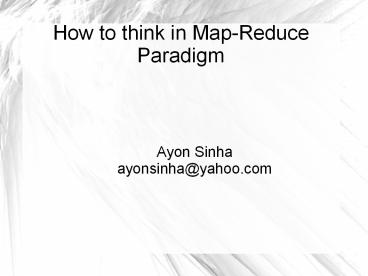How to think in Map-Reduce Paradigm - PowerPoint PPT Presentation
Title:
How to think in Map-Reduce Paradigm
Description:
Ayon Sinha ayonsinha_at_yahoo.com Overview Think Distributed, think super large data Convert single flow algorithms to MapReduce Q&A Think Keys and values Think about ... – PowerPoint PPT presentation
Number of Views:233
Avg rating:3.0/5.0
Title: How to think in Map-Reduce Paradigm
1
How to think in Map-Reduce Paradigm
- Ayon Sinha
- ayonsinha_at_yahoo.com
2
Overview
- Think Distributed, think super large data
- Convert single flow algorithms to MapReduce
- QA
3
Think Keys and values
- Think about the output first in terms of
Key-Value. e.g. - DimensionsMetrics (date, webpage, locale
users, visits, abandonment) - MembershipList of members (cluster centroid
representing HackerDojo students member1,
member2, .) - PropertyValue (userId name, location,
transactions, purchase Categories with
frequencies )
4
Thinking in MapReduce contd..
- How can the Mapper collect this information for
the reducers - How is the value distribution for keys
- Be very careful of the power-law distribution and
the curse of the last reducer - Know the appx. maximum number of values for the
reducer key - Input data independence
5
Example of Join in MapReduce
- Input
- User-id purchase-info data files
- User-id user-details data files
- Output
- User-id user details, category purchase with
frequencies
6
Example contd.
Reducer for one userID
Input to Reducer ltuserdId456gtD_John Doe, 123
main st, Home Town, CA P_Amazon Kindle 3 139
03/25/2011 P_Cowboy boots, 145,
04/01/2011 P_Aviator Sunglasses 69,
03/31/2011 .. Aggregate and emit from Reducer
ltuserId123 D_detailsgt
User details Mappers
ltuserId456 D_detailsgt
ltuserId459 D_detailsgt
ltuserId234 D_detailsgt
ltuserId678 D_detailsgt
ltuserId991 D_detailsgt
User purchase mappers
ltuserId991 P_purch-detailsgt
ltuserId123 P_purch-detailsgt
ltuserId678 P_purch-detailsgt
ltuserId234 P_purch-detailsgt
ltuserId456 P_purch-detailsgt
7
Ricky's Blog
- kmeans(data)
- initial_centroids pick(k, data)
- upload(data)
- writeToS3(initial_centroids)
- old_centroids initial_centroids
- while (true)
- map_reduce()
- new_centroids readFromS3()
- if change(new_centroids, old_centroids) lt
delta - break
- else
- old_centroids new_centroids
- result readFromS3()
- return result
8
Mapper and Reducer
9
Distance measures
- Euclidean distance
- Manhattan distance
- Jaccard Similarity
- Cosine similarity
- Or any other metric that suits your use-case
(faster the better) - Remember there is no such thing as absolute
similarity in real world. Even identical twins
may be dissimilar in some trait that can mark
them hugely dissimilar from that perspective.
e.g. 2 shirts of the same brand, color and
pattern is considered dissimilar by buyer if the
size is different, but they are similar for the
manufacturer.
10
K-Means Time complexity
- Non-parallel Algorithm
- K n O(distance function) num iterations
- Map Reduce version
- K n O(distance function) num iterations
O(M-R)/ s - O(M-R) O(K log K s (1/p)) where
- K is the number of clusters
- s is the number of nodes
- p is the ping time between nodes (assuming equal
ping times between all nodes in the network)
11
Recommendations
- Do not limit your thinking to one phase of
Map-Reduce. There are very few problems in the
real world that can be solved by a single
MapReduce phase. Think Map-Map-Reduce,
Map-Reduce-Reduce, Map-Reduce-Map-Reduce and so
on. - Partition and filter your data as early as
possible in the flow. What is the other reason
match-making sites ask for preferences before
running their massively parallel match
algorithms? - Apply simple algorithms first to large data and
slowly increase complexity as needed. Is the
added complexity and maintenance costs worth it
in a business setting? It has been shown by
Brill, Banko in Scaling to Very Very Large
Corpora for Natural Language Disambiguation,
2001, that vast amounts of data can help less
complex algorthims to perform equal or better
than more comlex one with less data. - Remember The curse of the last reducer. One
cluster will invariably(with real data) have way
more points to process than most others.
12
References
- Ricky Ho's blog Pragmatic Programming Techniques
- Collective Intelligence by Satnam Alag
- Programming Collective Intelligence by Toby
Segaran - Algorithms of the Intelligent Web by Marmanis,
Babenko - Brill, Banko.( 2001) Scaling to Very Very Large
Corpora for Natural Language Disambiguation































